trunk BUICK REGAL 1996 Owners Manual
[x] Cancel search | Manufacturer: BUICK, Model Year: 1996, Model line: REGAL, Model: BUICK REGAL 1996Pages: 356, PDF Size: 17.97 MB
Page 70 of 356

Just close your doors and turn on the ignition. All of the
doors will lock when
you move your shift lever out of
PARK (P) or NEUTRAL (N). All doors will unlock
automatically when the ignition is turned off.
If someone needs to get out while
the vehicle is running,
have that person use the manual or power lock. When
the
door is closed again, it will lock automatically as long as
the shift lever is
out of PARK (P) or NEUTRAL (N) and
the ignition is on. Note that the door must be opened,
then closed, or the door will not automatically relock.
If
you don’t .want the doors to unlock automatically
when
you turn the ignition off, you can remove the
LOCK CONTROL fuse in the instrument panel fuse
block. See “Fuses and Circuit Breakers” in the Index.
-,wing Your Vehicle
If you are leaving the vehicle, take your keys, open your
door and set the locks from inside. Then get
out and
close the door.
Remote Keyl. !c Entry (Option)
If your Buick has this option, you can lock and unlock your
doors
or unlock your trunk from up to 30 feet (9 m) away
using the key chain transmitter supplied with your vehicle.
Your Remote Keyless Entry transmitter operates on a
radio frequency subject to Federal Communications
Commission (FCC) Rules.
This device complies with
Part 15 of the FCC Rules.
Operation is subject to the following two conditions:
(1) This device may not cause harmful interference, and
(2) This device must accept any interference received,
including interference that may cause undesired operation.
Should interference to this system occur, try this:
a
a
0
a
Check to determine if battery replacement is
necessary. See the instructions on battery replacement.
Check the distance. You may be
too far from your
vehicle. This product has a maximum range.
Check the location. Other vehicles or objects may be
blocking the signal.
See your Buick dealer or a qualified technician for service.
Changes or modifications to this system by other than an
authorized service facility could void authorization to
use this equipment.
2-4
ProCarManuals.com
Page 71 of 356
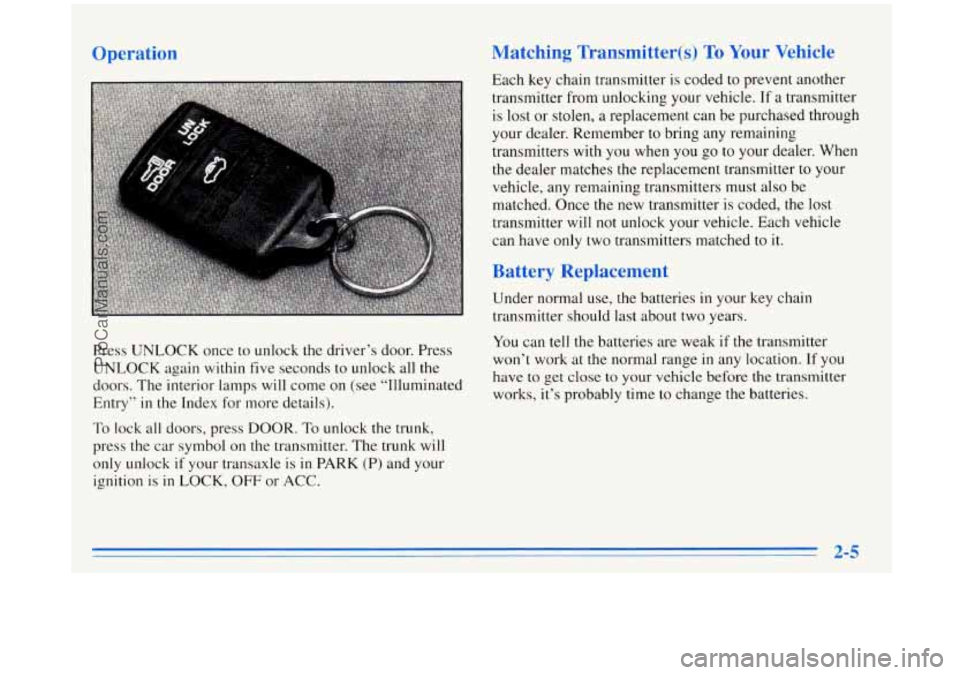
Matching Transmitter(s) To Your Vehicle
Each key chain transmitter is coded to prevent another
transmitter from unlocking your vehicle. If
a transmitter
is lost or stolen, a replacement can be purchased through
your dealer. Remember to bring any remaining
transmitters with you when
you go to your dealer. When
the dealer matches the replacement transmitter to your
vehicle, any remaining transmitters must also be
matched. Once the new transmitter is coded, the lost
transmitter will not unlock your vehicle. Each vehicle
can have only two transmitters matched to
it.
Battc ieplacemel
Under normal use, the batteries in your key chain
transmitter should last about two years.
Press UNLOCK once to unlock the driver’s door. Press
UNLOCK again within five seconds to unlock all the
doors. The interior lamps will come on (see “Illuminated
Entry” in the Index for more details). You
can tell the batteries are weak if the transmitter
won’t work at the normal range in any location.
If you
have to get close
to your vehicle before the transmitter
works, it’s probably time to change the batteries.
To lock all doors, press DOOR. To unlock the trunk,
press the car symbol on the transmitter. The trunk will
only unlock
if your transaxle is in PARK (P) and your
ignition is
in LOCK, OFF or ACC.
AC
ProCarManuals.com
Page 72 of 356

To replace your batteries:
1. Insert a flat object like a dime into the slot on the
back
of the transmitter. Gently pry apart the front
and back.
2. Gently pry the batteries out of the transmitter.
3. Put the new batteries into the transmitter as shown
on the transmitter. Use Duracell@ batteries, type
DL20 16, or equivalent.
4. Put the two halves back together. Make sure the
halves are together tightly
so water won’t get in.
5. Test the transmitter.
I
It can be dangerous to drive with the trunk open
because carbon monoxide (CO) gas can come into
your vehicle. You can’t see or smell
CO. It can
cause unconsciousness and even death.
If you must drive with the trunk open or if
electrical wiring
or other cable connections
must pass through the seal between the body
and
the trunk:
0 Make sure all windows are shut.
0 lbrn the fan on your heating or cooling
system to its highest speed with the setting on
VENT. That will force outside air into your
vehicle. See “Comfort Controls”
in the Index.
instrument panel, open them all the
way.
If you have air outlets on or under the
See “Engine Exhaust” in the Index.
ProCarManuals.com
Page 73 of 356

Trunk Lock Theft
To unlock the trunk from
the outside, insert the door
key and turn it.
You can also
press the car symbol
on
your Remote Keyless Entry
transmitter (if your vehicle
has this option).
Remote Trunk Release (Option)
Press the button behind the
glove box door to unlock
the trunk from the inside
of
your vehicle. Your transaxle
shift lever must be in
PARK (P). Remember that
your trunk can be opened
at any time using this
lock release. Vehicle theft is big business, especially in
some cities.
Although your Buick has
a number of theft-deterrent
features, we know that nothing we put
on it can make it
impossible to steal. However, there are ways you can help.
Key in the Ignition
If you leave your vehicle with the keys inside, it’s an
easy target for joy riders or professional thieves
-- so
don’t do it.
When you park your Buick and open the driver’s door,
you’ll hear a chime reminding you to remove your key
from the ignition and take it with you. Always do this.
Your steering wheel will be locked, and
so will your
ignition and transaxle. And remember to lock the doors.
Parking at Night
Park in a lighted spot, close all windows and lock your
vehicle. Remember to keep your valuables out of sight.
Put them
in a storage area, or take them with you.
2-7
ProCarManuals.com
Page 74 of 356
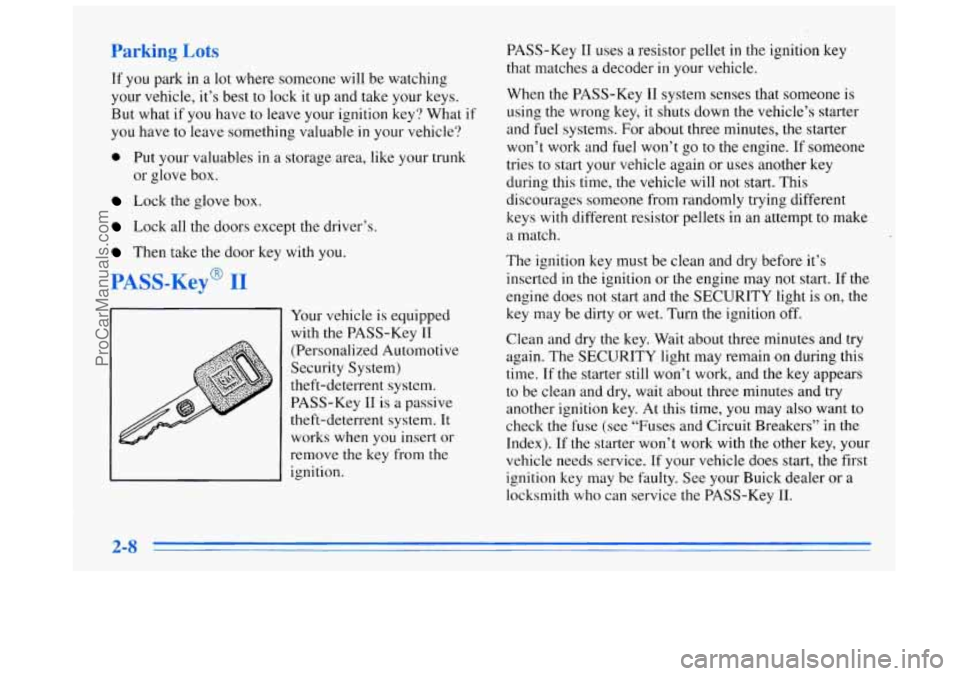
Parking Lots
If you park in a lot where someone will be watching
your vehicle, it’s best to lock it up and take your keys.
But what if you have to leave your ignition key? What if
you have to leave something valuable in your vehicle?
0 Put your valuables in a storage area, like your trunk
Lock the glove box.
Lock all the doors except the driver’s.
Then take the door key with you.
or glove
box.
Your vehicle
is equipped
with
the PASS-Key I1
(Personalized Automotive
Security System)
theft-deterrent system.
PASS-Key I1 is a passive
theft-deterrent system. It
works when you insert or
remove
the key from the
ignition. PASS-Key
I1 uses a resistor pellet
in the ignition key
that matches
a decoder in your vehicle.
When the PASS-Key I1 system senses that someone is
using the wrong key, it shuts down the vehicle’s starter
and fuel systems.
For about three minutes, the starter
won’t work and
fuel won’t go to the engine. If someone
tries to start your vehicle again or uses another key
during this time, the vehicle will not start. This
discourages someone from randomly trying different
keys
with different resistor pellets in an attempt to make
a match.
The ignition
key must be clean and dry before it’s
inserted in the ignition or the engine may not start.
If the
engine does not start and the SECURITY light is on, the
key may be dirty or wet. Turn
the ignition off.
Clean and dry the key. Wait about three minutes and try
again. The SECURITY light may remain on during this
time. If
the starter still won’t work, and the key appears
to be clean and dry, wait about three minutes and try
another ignition key. At this time, you may also want to
check the fuse (see
“Fuses and Circuit Breakers” in the
Index). If the starter won’t work with the other key, your
vehicle needs service.
If your vehicle does start, the first
ignition key may be faulty. See your Buick dealer or
a
locksmith who can service the PASS-Key 11.
2-8
ProCarManuals.com
Page 105 of 356
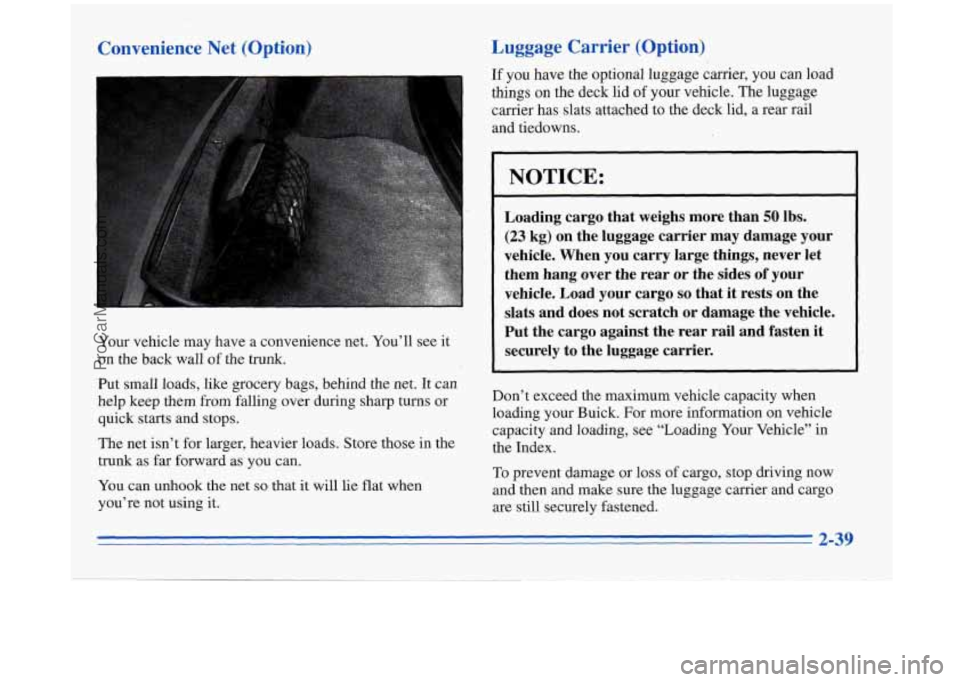
Convenience Net (Option)
I:x
Your vehicle may have a convenience net. You’ll see it
on the back wall of the
trunk.
Luggage Carrier (Option)
If you have the optional luggage carrier, you can load
things on the deck lid
of your vehicle. The luggage
carrier has slats attached to the deck lid, a rear rail
and tiedowns.
NOTICE:
~~
Loading cargo that weighs more than 50 lbs.
(23 kg) on the luggage carrier may damage your
vehicle. When you carry large things, never let
them hang over the rear or the sides of your
vehicle.
Load your cargo so that it rests on the
slats and does not scratch or damage the vehicle.
Put the cargo against the rear rail and fasten
it
securely to the luggage carrier.
Put small loads, like grocery bags, behind the net. It can
help keep them from falling over during sharp turns or
quick starts and stops.
The net isn’t for larger, heavier loads. Store those in the
trunk
as far forward as you can.
You can unhook the net
so that it will lie flat when
you’re not using it. Don’t exceed the maximum vehicle capacity when
loading your Buick. For more information on vehicle
capacity and loading, see “Loading Your Vehicle” in
the Index.
To prevent damage or loss of cargo, stop driving now
and then and make sure the luggage carrier and cargo are still securely fastened.
2-39
ProCarManuals.com
Page 175 of 356
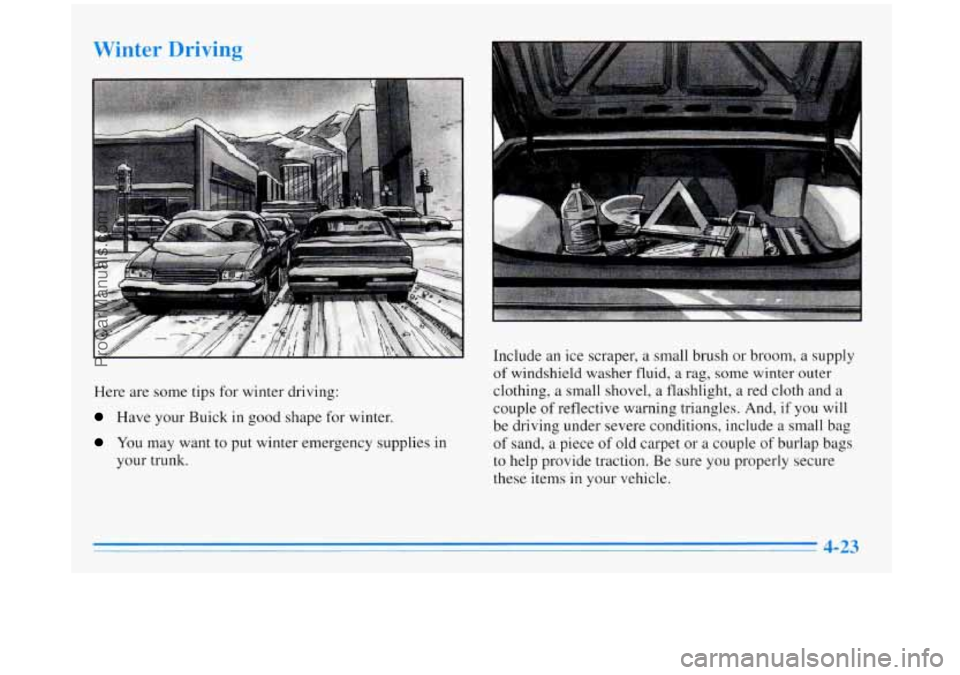
Winter Driving
Here are some tips for winter driving:
Have your Buick in good shape for winter.
You may want to put winter emergency supplies in
your trunk. Include
an ice scraper, a small brush or broom, a supply
of windshield washer fluid, a rag, some winter outer
clothing, a small shovel, a flashlight, a red cloth and a
couple of reflective warning triangles. And, if
you will
be driving under severe conditions, include a small bag
of sand, a piece of old carpet or a couple of burlap bags
to help provide traction. Be sure you properly secure
these items
in your vehicle.
ProCarManuals.com
Page 179 of 356
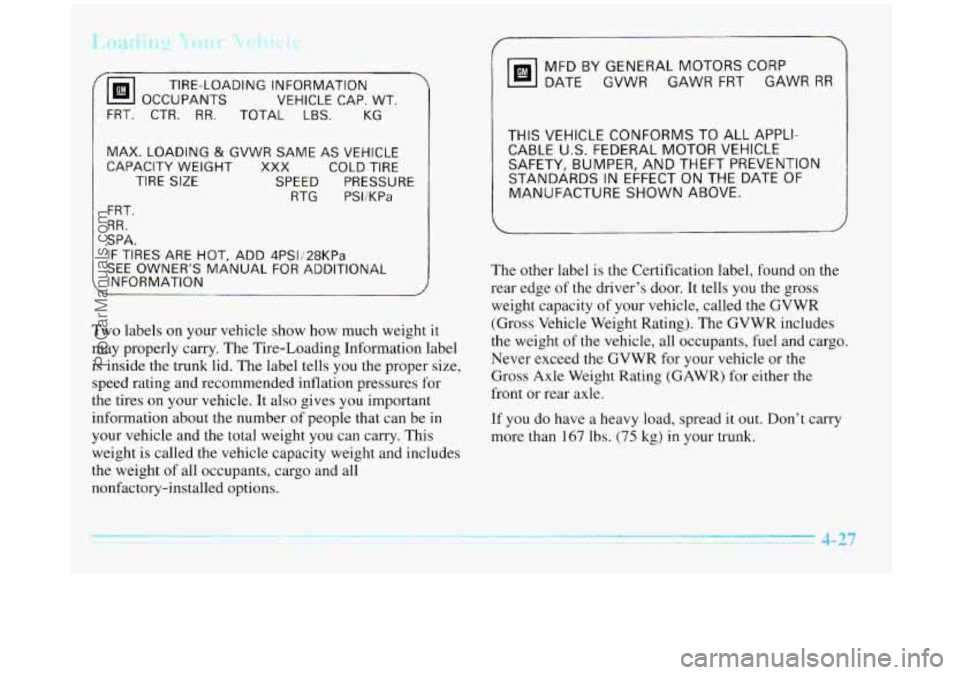
OCCUPANTS VEHICLE CAP. WT.
TIRE-LOADING INFORMATION
FRT. CTR.
RR. TOTAL LBS.
KG
MAX. LOADING
& GVWR SAME AS VEHICLE
CAPACITY WEIGHT XXX COLD TIRE
TIRE
SIZE SPEED PRESSURE
RTG
PSliKPa
FRT.
RR.
SPA.
IF TIRES ARE HOT, ADD 4PSIi28KPa
SEE OWNER‘S MANUAL FOR ADDITIONAL
. INFORMATION MFDBYGENERALMOTORSCORP
DATE GVWR GAWR FRT
GAWR RR
THIS VEHICLE CONFORMS TO ALL APPLI-
CABLE
U.S. FEDERAL MOTOR VEHICLE
SAFETY, BUMPER, AND THEFT PREVENTION
STANDARDS IN EFFECT ON
THE DATE OF
MANUFACTURE SHOWN ABOVE.
The other label is the Certification label, found on the
rear edge
of the driver’s door. It tells you the gross
weight capacity
of your vehicle, called the GVWR
Two labels on your vehicle show how much weight it
may properly carry.
The Tire-Loading Information label
is inside the trunk lid. The label tells
you the proper size,
speed rating and recommended inflation pressures for
the tires on your vehicle. It also gives you important
information about the number
of people that can be in If you do have a heavy load, spread it out. Don’t carry
your vehicle and the total weight you can carry. This more than
167 ibs. (75 kg) in your trunk.
weight is called the vehicle capacity weight and includes
the weight
of all occupants, cargo and all
nonfactory-installed options. (Gross
Vehicle Weight Rating). The GVWR includes
the weight of the vehicle, all occupants, fuel and cargo.
Never exceed the GVWR for your vehicle or the
Gross Axle Weight Rating (GAWR) for either the
front or rear axle.
4-27
ProCarManuals.com
Page 180 of 356
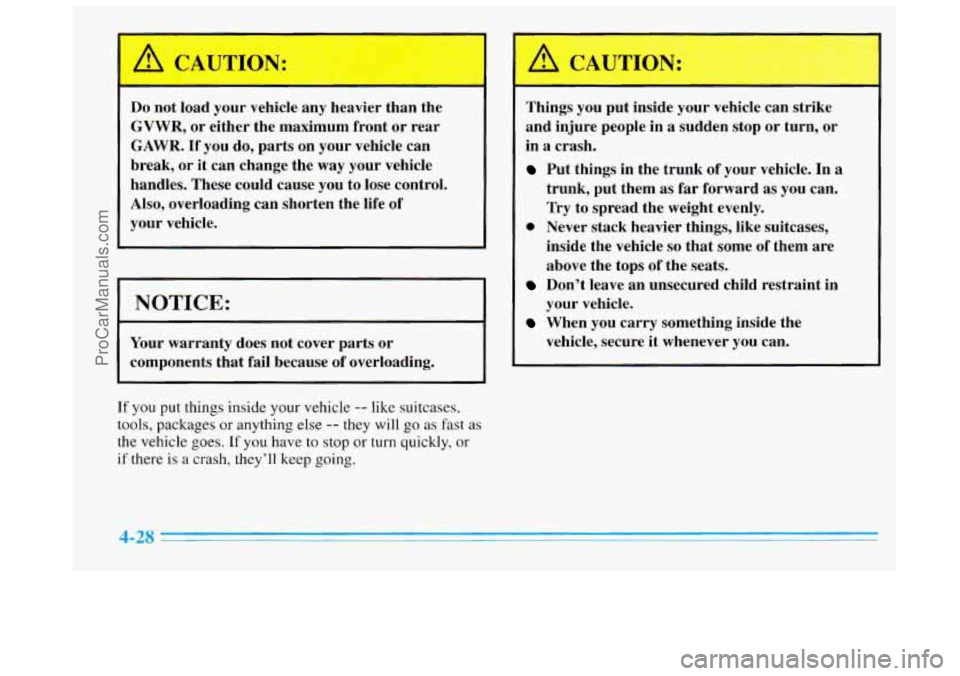
Do not load your vehicle any heavier than the
GVWR, or either the maximum front or rear
GAWR. If you do, parts on your vehicle can
break, or it can change the way your vehicle
handles. These could cause you to lose control.
Also, overloading can shorten the life of
your vehicle.
NOTICE:
Your warranty does not cover parts or
components that fail because of overloading.
If you put things inside your vehicle -- like suitcases,
tools, packages
or anything else -- they will go as fast as
the vehicle goes.
If you have to stop or turn quickly, or
if there is a crash, they’ll keep going.
Things you put inside your vehicle can strike
and injure people in
a sudden stop or turn, or
in
a crash.
Put things in the trunk of your vehicle. In a
trunk, put them as far forward as you can.
Try to spread the weight evenly.
0 Never stack heavier things, like suitcases,
inside the vehicle
so that some of them are
above the
tops of the seats.
Don’t leave an unsecured child restraint in
your vehicle.
When you carry something inside the
vehicle, secure it whenever you can.
4-28
ProCarManuals.com
Page 184 of 356
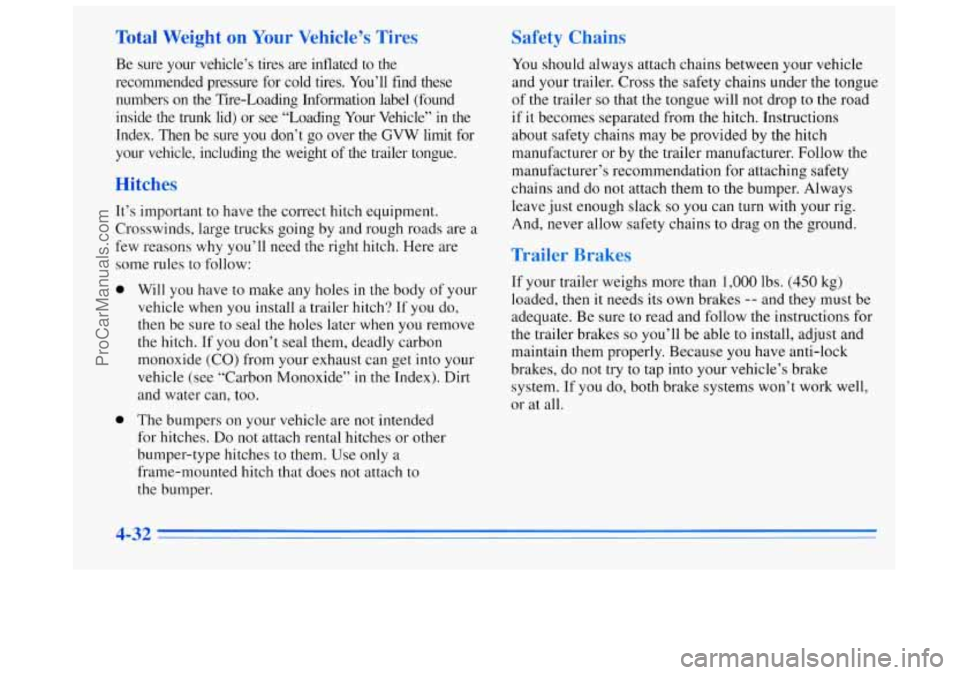
Total Weight on Your Vehicle’s Tires
Be sure your vehicle’s tires are inflated to the
recommended pressure for cold tires. You’ll find these numbers on the Tire-Loading Information label (found
inside the trunk lid) or see “Loading Your Vehicle”
in the
Index. Then be sure you don’t go over the
GVW limit for
your vehicle, including the weight of the trailer tongue.
Hitches
It’s important to have the correct hitch equipment.
Crosswinds, large trucks going by and rough roads are a
few reasons
why you’ll need the right hitch. Here are
some rules to follow:
0
0
Will you have to make any holes in the body of your
vehicle when you install a trailer hitch? If you do,
then be sure to seal the holes later when you remove
the hitch. If you don’t seal them, deadly carbon
monoxide (CO) from your exhaust can get into your
vehicle (see “Carbon Monoxide”
in the Index). Dirt
and water can, too.
The bumpers on your vehicle are not intended
for hitches.
Do not attach rental hitches or other
bumper-type hitches
to them. Use only a
frame-mounted hitch that does not attach to
the bumper.
Safety Chains
You should always attach chains between your vehicle
and your trailer. Cross the safety chains under the tongue
of the trailer
so that the tongue will not drop to the road
if it becomes separated from
the hitch. Instructions
about safety chains may be provided by the hitch
manufacturer or by the trailer manufacturer. Follow the
manufacturer’s recommendation for attaching safety
chains and do not attach them to the bumper. Always
leave just enough slack
so you can turn with your rig.
And, never allow safety chains to drag on the ground.
Trailer Brakes
If your trailer weighs more than 1,000 lbs. (450 kg)
loaded, then
it needs its own brakes -- and they must be
adequate. Be sure to read and follow the instructions for
the trailer brakes
so you’ll be able to install, adjust and
maintain them properly. Because you have anti-lock
brakes, do not try to tap into your vehicle’s brake
system. If you do, both brake systems won’t work well,
or at all.
4-32
ProCarManuals.com